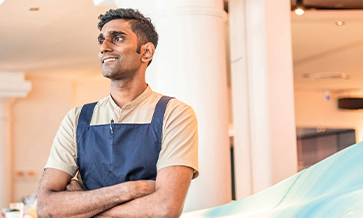If anyone can claim to have mastered the fine art of single malt whisky making, it is undoubtedly the Scottish distillery, Whyte & Mackay. James Cordiner, an International Malt Specialist for the company, has studied an M.Sc. in Distilling and has extensive hands-on experience in the field, which includes production, marketing, and even bartending. Alongside, Jake Saunders, Marketing Manager for Developing Markets, spoke with Roy Thomas about the craftsmanship and the meticulous processes that makes Whyte & Mackay whiskies among the best in the world.
How does Whyte & Mackay distinguish itself in the highly competitive world of whisky, particularly in malt whisky production?
James: Whyte & Mackay has a range of whiskies, including Dalmore, Jura, Fettercairn, and Tamnavulin. Currently, Dalmore and Jura are available in India, with Tamnavulin coming soon.
Dalmore stands out due to its long history and focus on modern luxury consumers. We produce what we describe as masterpieces of malt whisky. Our unique, idiosyncratic stills produce a robust spirit with citrus and malty notes, which is ideal for long maturation.
We meticulously select our casks from top sherry bodegas and wineries across Europe, hand-picking them for the maturation process. Our expert whisky makers – who have learned from their predecessors through an unbroken chain of almost 200 years since the distillery began – then carefully curate the spirits progress until a masterpiece is made. This dedication to quality sets Dalmore apart from many competitors.
What key factors influence the flavour profile of single malt whisky?
James: The flavour profile of single malt whisky is influenced by several factors, despite the use of only three legally permitted ingredients: malted barley, water and yeast. Key factors include the duration of fermentation; the size and shape of stills play a crucial role in determining the flavours carried through to the spirit; and cask maturation:
Approximately 60-70% of a whisky’s flavour comes from the maturation process and the cask type. Various cask types, such as American oak, sherry, and port casks, contribute different flavour profiles to the whisky.
How does the ageing process affect the characteristics of malt whisky and what role does cask type play in this? What are the newer cask finishes you are seeing being used?
James: Cask type is crucial for whisky aging. American oak or ex-bourbon casks impart sweet flavours like vanilla and honey notes, while sherry casks add rich, spicy, and dried fruit flavours. Port casks provide additional tastes of rich berry and plum whilst other types, like Mizunara or rum casks, also offer unique flavours.
Historically, whisky maturation likely involved using local oak casks for storage purposes. Over time, experimenting with various cask types has become common. Dalmore has a rich tradition of using sherry casks and has maintained relationships with sherry producers like Gonzales Byass since at least 1915, obtaining exclusive casks of the world’s finest sherry.
We also use port casks from Graham’s in Portugal and various French wine casks from some of Europe’s most prestigious vineyards. Our approach to cask curation is complex, usually involving initial maturation in American Oak ex-Bourbon casks, followed by splitting the spirit into a variety of others cask types for finishing to develop unique flavour profiles, before marrying the whisky together for bottling. An approach which takes more time and costs more money, but results in exquisite whiskies as a result.
Can you describe a typical day in your role as an international malt specialist?
James: There is no typical day, but my role involves a range of activities. Based in Dubai, I cover the UAE and India. My work includes conducting whisky tastings, hosting bar events, and educating bartenders about our whisky portfolio.
Upcoming events include a bar takeover at The Leela Palace in Delhi and participating in luxury events like the launch of our ‘Cask Curation’ set in Dubai.
What trends are you currently observing in the global malt whisky market, and how is Whyte & Mackay responding to them?
Jake: Single malt whisky continues to rise in popularity, particularly in India, which has recently become the largest importer of Scotch in the world. This growth has prompted Whyte & Mackay to focus on advocating for brands like The Dalmore and Jura in the Indian market.
While there is emerging competition from Indian single malts, which mature faster in many aspects due to the warmer climate, this growth helps develop the overall whisky market. As more consumers in India start with local Indian Single Malts, they are likely to then explore into Scotch single malts, thus expanding the category.
How do you approach the process of selecting and blending malts to create a unique whisky expression?
James: At The Dalmore, selecting and blending malts is a meticulous process. While mass production might use cheaper casks and simple aging, we take a more refined approach. We hand-select casks from various producers and carefully curate them, not just transferring whisky from one cask to another but spreading it across different cask types for carefully monitored time periods to achieve desired flavours.
Each year, our maturation team visits Scotland in November to inspect each cask individually. They nose and taste samples, grading each cask based on flavour and quality, determining its direction. This hands-on approach is vital for creating our unique expressions.
Our whisky making team at The Dalmore, led by Master Whisky Maker Gregg Glass and Master Distiller Richard Patterson (OBE), along with Blend Controller Margaret Nicol, oversees this process. Richard has been with us for over 50 years. Together with the team, they ensure that every cask meets our high standards.
What are some of the most memorable or challenging projects you’ve worked on with Whyte & Mackay?
James: In my brief time with Whyte & Mackay, I’ve had several memorable experiences. I visited our distilleries in Scotland, which provided a fantastic insight into the hands-on approach and traditional craftsmanship involved.
Following that, I travelled to Portugal with other ambassadors and malt specialists to learn about port casks, which are used in some of our luxury whisky releases. My first trip to India has also been exciting, allowing me to see the burgeoning whisky scene and potential for Dalmore and Jura in the market.
Can you discuss any upcoming releases or new developments from Whyte & Mackay that you’re particularly excited about?
Jake: For the Indian market, we currently have the Dalmore 12-Year-Old, Portwood, and 15-Year-Old. We’re also currently launching the Dalmore 18-Year-Old, which is starting to become available across different states with plans to expand our luxury expressions.
Globally, after a very successful first edition launched last year in celebration of our longstanding relationship with the Gonzalez Byass family in Jerez, Spain, we’re launching the second series of our Cask Curations set next month.
The first edition consisted of only 150 sets available around the world, each with three exquisite hand-selected expressions of The Dalmore 26-YO, 28-YO and 43-YO which used rare and aged sherry casks from Gonzalez Byass, and each set costing around ?30 lakhs. The second edition will celebrate another of our long-standing partnerships which will be revealed next month at the regional launch in Dubai.
For Jura, we have the 10-YO, 12-YO and 18-YO available in India, with a new Bourbon cask, non-age statement whisky coming soon. This will be at an affordable price point to attract new consumers to single malts.
We are also excited about introducing Tamnavulin to the Indian market by the end of this year or early next year. Tamnavulin, a Speyside single malt, offers fantastic flavours and is more accessible in terms of pricing compared to The Dalmore and Jura.
What role does innovation play in your work, and how do you balance tradition with modern techniques?
James: Tradition is crucial for us at Whyte & Mackay, given our long history at The Dalmore and Jura. We have an unbroken chain of whisky makers from Alexander Matheson to Gregg Glass. This tradition is complemented by innovation, such as exploring new cask types and finishes.
We use exclusive casks like the 30-year-old Matusalem sherry casks from Gonzalez Byass for The Dalmore, ensuring a deep, rich influence on the whisky. Our approach includes both maintaining traditional practices and experimenting with new methods to create exciting products.
Do you still use pot stills?
James: Yes, for single malt whisky, we use copper pot stills, which are essential for flavour development. Unlike column stills used for grain whisky, pot stills allow for more complex flavours. The copper reacts with the spirit to remove undesirable flavours and enhance the spirit’s quality. The unique shapes and sizes of our stills at the Dalmore contribute to a rich, robust spirit ideal for long maturation.
How would you distinguish Indian single malt from Scottish single malt?
James: Neither country is limited to which barley type they use. However, due to growing conditions, cost and availability, most Indian single malts use siz-row barley. While six-row barley has higher protein content, which affects yield, it doesn’t drastically change flavour compared to two-row barley mostly used in Scotland, which has higher starch yields but has a higher premium cost attached.
The primary difference often lies in the production regulations and climate effects. Scotch whisky benefits from strict regulations and a cooler climate, which protects minimum quality and impacts maturation and flavour development, allowing for whisky to be aged slowly for long periods of time and developing complex and unique flavours.
Indian whisky is improving, with a diverse range of quality levels emerging in the market, and some remarkable new single malts available, taking advantage of the quicker effects of higher temperatures on the maturation process.
How is Whyte & Mackay committed to being more sustainable in the future?
James: The company aims to be carbon-neutral by 2030 and achieve Net Zero by 2040, surpassing the targets set by the Scottish and UK governments. We have installed an anaerobic digester (AD) at the Invergordon grain distillery to produce green gas from distilling co-products, which will power their Northern distilleries at Invergordon and Dalmore.
Fettercairn and Tamnavulin will utilise local AD plants, and a new biomass boiler using sustainable wood pellets is set to be installed at the Jura distillery. Additionally, all sites operate on carbon-neutral electricity, and EV charging points are available at every location.
In terms of agriculture and biodiversity, Whyte & Mackay is working on projects like restoring 447 acres of peatland with Nature Scot & Wyvis Estate and planting 13,000 oak saplings behind the Fettercairn Distillery. These efforts aim to create a sustainable Scottish oak forest for future cask production.
We are also partnering with a Speyside cooperage to build casks from local wind-felled trees and will soon focus on marine enhancement projects, including sea grasses and mussels for water purification.














